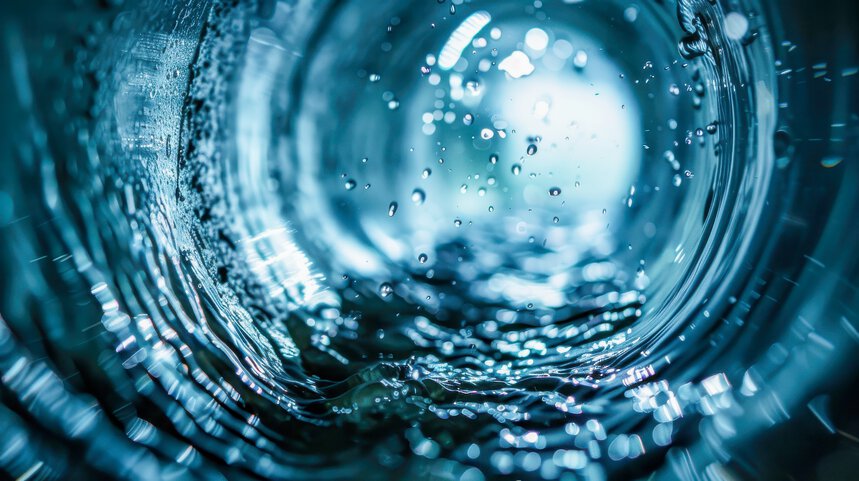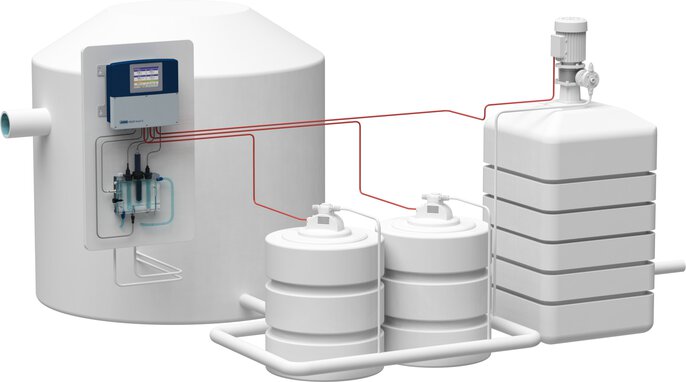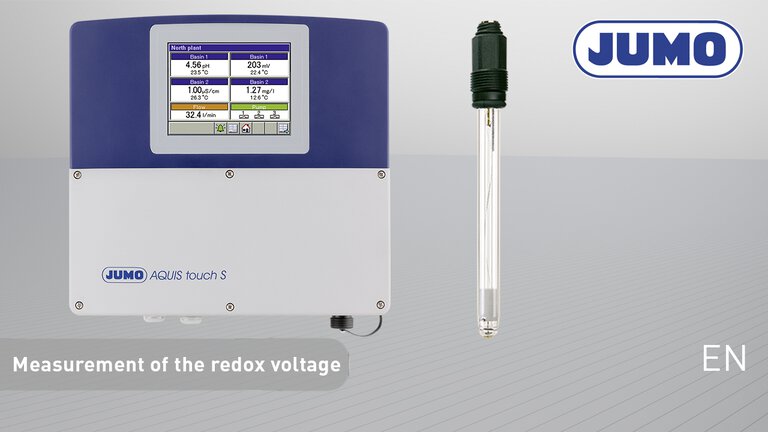

Redox - how to measure it and what if the value deviates?
Knowledge of redox is essential for monitoring chemical balance in water systems. But what is redox and how do you measure it? What do you need to pay attention to and which redox sensor is most suitable? JUMO is a manufacturer of proven analytical measuring equipment. In this blog, we answer the most frequently asked questions about redox and how to measure it.
In this blog, we cover:
What does redox mean?
Redox, also known as ORP (Oxidation Reduction Potential), is measured in liquids such as water. Measuring redox provides insight into a liquid's ability to break down contamination or, conversely, to create a stable, non-oxidizing environment. The term “redox” is a contraction of two fundamental chemical processes:
- Oxidation: a chemical process in which a substance loses electrons. In water purification, this often means breaking down contaminants such as organic material, bacteria, and viruses. Think of chlorine, which oxidizes (destroys) bacteria.
- Reduction: the opposite process, in which a substance gains electrons.
These two processes always occur simultaneously: when one substance loses electrons (oxidation), another substance must absorb them (reduction). Hence the term “redox.”
What is a redox reaction? (with example formula)
A redox reaction is a chemical reaction that occurs between two substances, involving the exchange of electrons: oxidation (release of electrons) and reduction (acceptance of electrons).
Example formula:
Consider the reaction between chlorine (Cl₂) and iron(II) ions (Fe²⁺) in water:
Reaction equation:
Fe²⁺ (aq) + Cl₂ (aq) → Fe³⁺ (aq) + 2 Cl⁻ (aq)
This equation can be split into two partial reactions:
Oxidation (iron loses an electron):
Fe²⁺ → Fe³⁺ + e⁻
Reduction (chlorine accepts electrons):
Cl₂ + 2 e⁻ → 2 Cl⁻
In this reaction, Fe²⁺ donates an electron (oxidation) and Cl₂ accepts electrons (reduction). Together, these two partial reactions form the complete redox reaction.
Why is this important?
In water systems, such as swimming pools or drinking water installations, these types of reactions are essential for breaking down contaminants and ensuring safe water quality. By measuring the redox value, you gain insight into the extent to which these reactions can take place.
What does redox potential (mV) mean?
The redox value is expressed in millivolts (mV). It measures the electrical potential difference between a special measuring electrode (usually made of platinum) and a reference electrode, both of which are placed in the liquid.
- A higher, positive mV value (e.g., +600 mV to +800 mV for swimming water) indicates a strong oxidizing capacity. This means that there are many active substances present that can effectively break down contaminants. This is often desirable in applications where disinfection is important, such as in swimming pools.
- A lower, negative mV value indicates a reducing environment. This can occur in water with a lot of organic material or little oxygen, where there is a tendency to “give off” electrons rather than absorb them.
Do you know what you need to do to adjust the redox value?
The redox value deviates
When the redox value deviates from the desired standard, it is important to consider the specific context and the goals you want to achieve with your water treatment. In any case, take the following considerations into account:
- pH is crucial: the pH value has a huge impact on your redox measurement. Therefore, always measure pH and ORP simultaneously. For chlorine disinfection, for example, an optimal pH of 7.0-7.6 is essential for an effective redox value.
- Temperature: Temperature can influence redox measurements, although the influence is generally less significant than that of pH.
- Electrode type: The specific construction of the redox sensor (e.g., silver/silver chloride reference) may result in slight differences in absolute values. However, the trend and response to changes remain consistent.
- Calibration: Regular calibration of your redox sensor is essential for accurate and reliable measurements.
If the redox value of water is too low, this means that its oxidizing capacity or disinfecting power is insufficient. This is often a problem when clean and safe water quality is desired.
How can you increase the redox value?
1. Add desinfectants/oxidants:
Chlorine: The most common and effective method for swimming pools and spas. It immediately increases the number of oxidisers and thus the redox value.
Ozone: If you have an ozone generator, administering ozone can significantly increase the redox value, as ozone is a powerful oxidising agent.
Hydrogen peroxide or bromine: Depending on the system and preference, these agents can also be used to increase the redox value.
2. Check and optimize the pH value:
The pH value has a major influence on the effectiveness of disinfectants such as chlorine. Chlorine is most effective at a pH between 7.0 and 7.6.
Is the pH value too high? Then lower it with a pH reducer (such as sulphuric acid or hydrochloric acid). A pH value that is too high causes chlorine to work less effectively, resulting in a lower ORP (redox) value.
3. Improve water filtration and reduce organic pollution:
Organic contamination (leaves, oils, algae) consumes disinfectants and lowers the ORP value.
Ensure proper filtration: Run your filter long enough and clean or rinse it regularly.
Remove visible contamination: Scoop debris out of the water and clean surfaces consistently.
4. Ensure sufficient water circulation:
Good water circulation ensures that disinfectants are effectively distributed throughout the system, contributing to a stable and higher ORP value.

Checking pH values is essential for correct redox measurement
How can you lower the redox value?
Sometimes it is necessary to achieve a lower redox value, for example in specific industrial processes or biological systems. This indicates a reducing environment.
Add reducing agents:
- Sulphur compounds: such as sodium sulphite and bisulphite, can neutralise chlorine (dechlorinate) or reduce specific metal ions.
- Iron salts (ferrous salts): can be used to reduce chromium in wastewater treatment.
- Biological activity: in some biological systems (such as aquariums or anaerobic bioreactors), specific bacteria can lower the redox value.
What if you could use a single sensor not only to measure the quality of your water, but also to predict how it will behave?
What is a redox sensor?
A redox sensor, also known as an ORP sensor, is an electrochemical instrument that measures the redox potential of a liquid. This potential indicates how strongly a solution tends to give up electrons (oxidise) or take up electrons (reduce).
How is a redox sensor constructed?
An ORP sensor operates on an electrochemical principle and typically consists of three main components:
1. Measuring electrode:
Usually made of a precious metal such as platinum. Platinum is chemically inert and acts as a catalyst for electron exchange. It measures the electrical potential created by the balance between the oxidising and reducing substances in the measuring medium.
- When there is a high concentration of oxidising substances in the liquid, electrons move from the platinum electrode to the liquid, causing the electrode to become positively charged.
When there is a high concentration of reducing agents in the liquid, electrons move from the liquid to the platinum electrode, causing the electrode to become negatively charged.
2. Reference electrode:
This electrode provides a stable and constant reference potential against which to compare the measurement from the measuring electrode. This is often a silver/silver chloride electrode (Ag/AgCl).
3. Elektrolyte and membrane:
The electrolyte is the conductive liquid that enables the electrical connection between the measuring and reference electrodes. The membrane is a small, porous component (ceramic, polymer, etc.) that forms the barrier between the internal electrolyte and the external measuring solution, for controlled ion exchange.
How does a redox sensor work?
The redox sensor measures the voltage difference (in millivolts) between the measuring electrode and the reference electrode:
Redox reaction in the solution:
Oxidation and reduction reactions take place in the solution, during which electrons are exchanged between substances. The measuring electrode registers the electrical voltage generated by these reactions.
Comparison with the reference electrode:
The reference electrode provides a stable reference point. The voltage difference between the two electrodes is measured and displayed as the ORP or Redox value.
Display of the redox value:
The redox sensr is expressed in millivolts (mV).
- A positive value indicates an oxidising environment (e.g. with a lot of oxygen or chlorine).
- A negative value indicates a reducing environment (e.g. with little oxygen and a lot of organic material).
What is the lifespan of a redox sensor?
The lifespan of a redox sensor can vary greatly, but generally ranges from 6 months to 2 years with routine use under average conditions. Some high-quality sensors can even last up to 3 years with proper care and maintenance.The lifespan of your redox sensor is not determined by chance, but by electrochemistry and maintenance.
What affects the lifespan of the redox sensor?
Frequency of use
The more frequently the sensor is used (especially for continuous measurements), the faster it wears out. Occasional use extends its service life.
Type of measuring medium/liquid
- Aggressive chemicals: strong acids, bases, solvents, or high concentrations of oxidants (such as chlorine or ozone) can damage the measuring and reference electrodes, shortening their service life. Type of measuring medium/liquid
- Contamination: Oil, grease, proteins, algae, or other solid particles can form a coating on the electrodes and junction, reducing accuracy and rendering the sensor unusable if regular cleaning is not performed.
- Demineralized water: highly pure water can dilute the internal electrolyte of the reference electrode (due to osmotic effects), which significantly reduces its service life.
Temperature
Higher temperatures accelerate the degradation of sensor materials. A rule of thumb is that the service life is halved for every 25 °C increase in temperature:
- At 25 °C: 1-2 years
- At 50 °C: 6-12 months
- At 75 °C: 3-6 months
How do you maintain and store the redox sensor?
With proper care and attention to maintenance and storage, the service life of the redox sensor can be significantly extended and reliable measurement guaranteed:
Prevent dehydration
An ORP sensor, especially the reference electrode, should never be allowed to dry out. Always store the sensor with the protective cap filled with the appropriate storage solution (often a KCI solution or pH 4/7 buffer). Drying out can render the reference electrode unusable.
Cleaning
Clean the sensor regularly and remove coatings and dirt. Preferably after each use, but certainly on a regular basis.
Calibrate
Calibrate the sensor regularly. By calibrating the sensor regularly, you maintain accurate results and can recognize in good time when the sensor is no longer functioning correctly and needs to be replaced.
JUMO offers comprehensive calibration services, both in its own laboratories and on site.
Conclusie: control over redox = control over quality
Redox measurement is not only about understanding the chemical basis, but above all about translating that knowledge into practice. By gaining insight into what redox is, how the potential behaves, and which factors influence the value, it becomes clear how essential this variable is for water quality and process control. With a well-chosen and properly maintained redox sensor, you have an instrument that not only provides accurate measurements but also performs reliably over time. This makes redox measurement an indispensable link between theory, measurement practice, and the certainty of stable and safe processes.
About the author
My name is Saskia van der Laan and I have been working in content marketing for several years. I enjoy combining my professional skills with my passion for writing, with the aim of informing and inspiring others. Outside of work, I enjoy walking my dog, reading, and participating in sports.
Visit my LinkedIn page.
About the Field Application Engineer
My name is Marco Teunizen. As a Field Application Engineer, I translate technology into practice. Providing technical solutions for a wide range of applications is my passion. Outside of work, I enjoy being active outdoors, playing sports, and going on outings with my family.
Visit my LinkedIn page.

Marketing
Saskia van der Laan - Marketing coordinator +31294768050 Saskia.vanderLaan@jumo.net +31294768050

